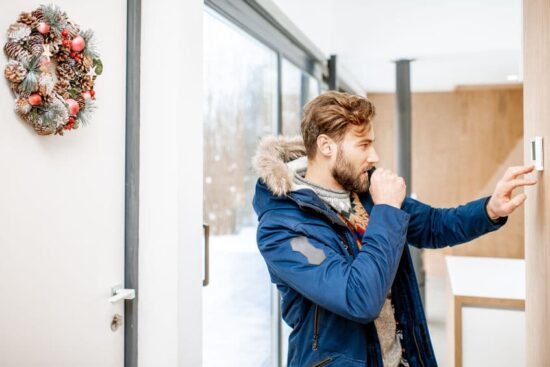Since our heating and air conditioning systems occupy the largest portion of our energy bills, finding ways to reduce it’s cost is paramount for those of us who want to save money. One way to do this is by finding the most optimal thermostat setting for the Winter months. In a previous post, we went over the best thermostat setting for Summer months in order to save money. But, what about Winter?
Let’s get into this question and more!
What Temperature Should You Set Your Thermostat to in the Winter?
In our post covering the thermostat setting for Summer, we shared that the Department of Energy recommends setting the temperature to 78 degrees (F) to start saving money. Most of us like the keep our AC operating anywhere from 70-74 degrees, so you can see how savings would begin to take place if we set it to 78 degrees instead.
Well, for Winter, we want to do the opposite. Rather than raising the temperature of the thermostat, we want to lower it for optimal savings. Most people like their temperature setting at around 72 degrees (F). The starting point for effective energy savings is said to be around 68 degrees in the Winter. Since the average savings ratio is around 1% to every 1 degree of temperature change, this would equate to around 4% – 5% of savings. If you (and those you live with or work with) can handle reducing the temperature even more, then go for it. 60 – 65 degrees would be optimal because this is around 10 degrees lower than the average setting. This is where real savings begins coming in.
Another helpful tip is to lower the temperature when you and your household go to bed at night (or day). If you can manage to set the temperature somewhere in the 50’s during this time, you can gain another 15% of savings!
Now that we’ve covered the best winter thermostat settings while you are home, let’s get into some recommendations for when you are away.
What’s the Best Setting When Away?
When you are away in the Winter months, on vacation for example, we recommend leaving the thermostat set to around 50 degrees (F). This will provide savings while also preventing any pipes from freezing. If you are out of the house or away from your business for more than 8 hours at a time, then lowering the thermostat during these times can certainly increase your savings as well.
We’d recommend lowering the temperature at least 10 degrees while you’re away for optimal savings.
Doesn’t Turning the System Completely Off Equate to Better Savings?
When it comes to your thermostat’s setting when you are away, we don’t recommend turning the system off completely. While this can be beneficial in the Summer, it can cause issues in the Winter, especially when it’s below freezing outside. Frozen pipes is one example and you want to avoid this at all costs. Frozen pipes can burst and cause more expenses in damages than you would save by turning the system off.
Related: 6 Tips to Winterize a Vacant Home
One Last Helpful Tip
When it comes to adjusting the thermostat whenever you leave and/or arrive, it can be a challenge to remember to do it every time. This is where a programmable thermostat can come in handy. A programmable thermostat can be “programmed” to increase or decrease the set temperature at certain times of the day. This way it adjusts the temperature automatically. Smart thermostats also provide this function, while also allowing you to adjust the thermostat even when you are away, via the internet.
According to Energy.gov, a savings of 10% – 20% can be achieved by using a programmable thermostat and up to 23% with the addition of a smart thermostat.
What has been your experience with adjusting your thermostat in the Winter? Have you experienced savings? Do you have more tips to add?
Feel free to comment below. We’d love to hear from you!



